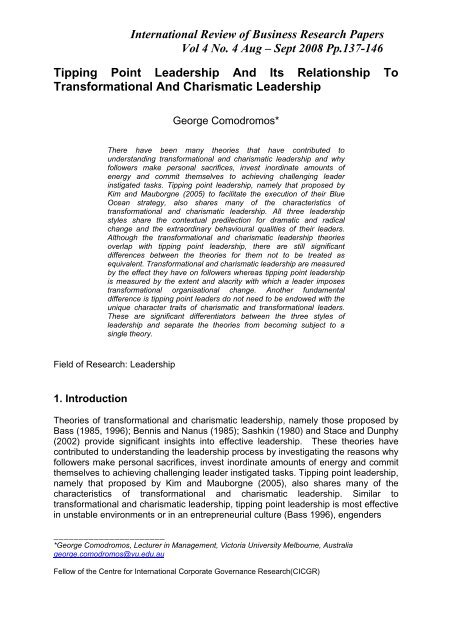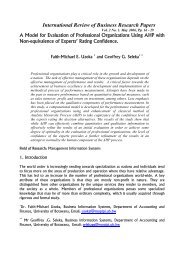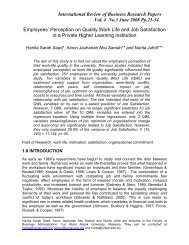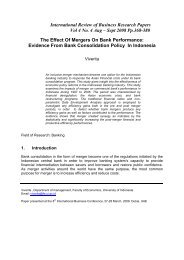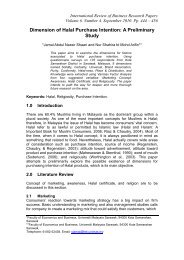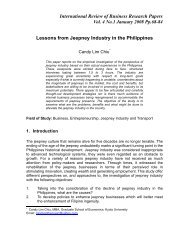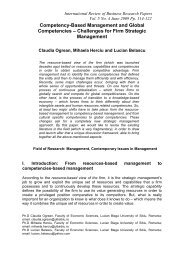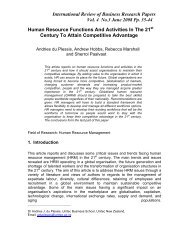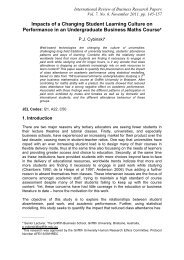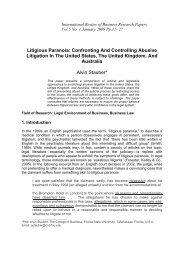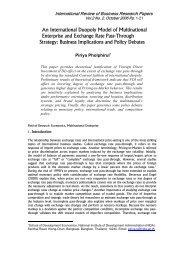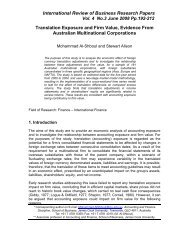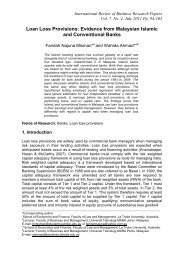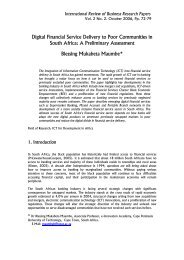Tipping Point Leadership And Its Relationship To Transformational
Tipping Point Leadership And Its Relationship To Transformational
Tipping Point Leadership And Its Relationship To Transformational
You also want an ePaper? Increase the reach of your titles
YUMPU automatically turns print PDFs into web optimized ePapers that Google loves.
International Review of Business Research PapersVol 4 No. 4 Aug – Sept 2008 Pp.137-146<strong>Tipping</strong> <strong>Point</strong> <strong>Leadership</strong> <strong>And</strong> <strong>Its</strong> <strong>Relationship</strong> <strong>To</strong><strong>Transformational</strong> <strong>And</strong> Charismatic <strong>Leadership</strong>George Comodromos*There have been many theories that have contributed tounderstanding transformational and charismatic leadership and whyfollowers make personal sacrifices, invest inordinate amounts ofenergy and commit themselves to achieving challenging leaderinstigated tasks. <strong>Tipping</strong> point leadership, namely that proposed byKim and Mauborgne (2005) to facilitate the execution of their BlueOcean strategy, also shares many of the characteristics oftransformational and charismatic leadership. All three leadershipstyles share the contextual predilection for dramatic and radicalchange and the extraordinary behavioural qualities of their leaders.Although the transformational and charismatic leadership theoriesoverlap with tipping point leadership, there are still significantdifferences between the theories for them not to be treated asequivalent. <strong>Transformational</strong> and charismatic leadership are measuredby the effect they have on followers whereas tipping point leadershipis measured by the extent and alacrity with which a leader imposestransformational organisational change. Another fundamentaldifference is tipping point leaders do not need to be endowed with theunique character traits of charismatic and transformational leaders.These are significant differentiators between the three styles ofleadership and separate the theories from becoming subject to asingle theory.Field of Research: <strong>Leadership</strong>1. IntroductionTheories of transformational and charismatic leadership, namely those proposed byBass (1985, 1996); Bennis and Nanus (1985); Sashkin (1980) and Stace and Dunphy(2002) provide significant insights into effective leadership. These theories havecontributed to understanding the leadership process by investigating the reasons whyfollowers make personal sacrifices, invest inordinate amounts of energy and committhemselves to achieving challenging leader instigated tasks. <strong>Tipping</strong> point leadership,namely that proposed by Kim and Mauborgne (2005), also shares many of thecharacteristics of transformational and charismatic leadership. Similar totransformational and charismatic leadership, tipping point leadership is most effectivein unstable environments or in an entrepreneurial culture (Bass 1996), engenders______________________*George Comodromos, Lecturer in Management, Victoria University Melbourne, Australiageorge.comodromos@vu.edu.auFellow of the Centre for International Corporate Governance Research(CICGR)
3. <strong>Tipping</strong> <strong>Point</strong> <strong>Leadership</strong> ModelComodromos 139Kim and Mauborgne (2005) suggest the application of tipping point as a leadershipmodel, ‘the idea that once belief and energies of a critical mass of people areengaged, conversion to new ideas will spread quickly, bringing about rapidfundamental change’, to the execution of a particular type of innovation, namely, BlueOcean strategy. Kim and Mauborgne (2005) go on to state that a number oforganisational hurdles would need to be overcome in order to facilitate the impetusfor change and reduce resistance. These are namely, cognitive, resource,motivational and political hurdles, which need to be overcome in a timely fashion,using existing resources. Further, the change process is premised on a principle offairness and the “three E principles”: engagement, explanation and expectancy clarity(Kim and Morborgne,2005).The cognitive shift that is required to trigger the tipping point phenomenon comes intoeffect by making subordinates ‘see and experience harsh reality first hand’. This nota new concept; it dates back to Plato and the cave and the Kantian proposition thatreality is ‘all in the mind’. Kim and Mauborgne have provided an extensive case studydealing with the New York Police Department (NYPD), and how they reduced thecity’s crime rate, to illustrate the concept that negative experience can lead toenforced change. The CEO of the NYPD, Bill Bratton enabled his precinct captains toovercome the cognitive hurdle of city’s crime rate by forcing them take the city’s crimeridden subway to work. In order for the tipping point phenomenon to be able to comeinto effect, there needs to be ‘a fast change in mindset that is internally driven ofpeople’s own accord’ (Kim and Mauborgne 2005). A confronting experience with theissue will provide the necessary climate to foster an epidemic movement toward andidea.Once the need for strategic shift is accepted and the cognitive hurdle is overcomeleaders are then faced with the issue of limited resources. Kim and Mauborgne(2005) suggest that the allocation of resources be firstly made to ‘hot spots’. Theadditional allocation of resources needed for these ‘hot spots’ can come from ‘coldspots’ that do no have the same pressing needs. A system of ‘horse-trading’ ofresources is thus implemented to fill necessary resource gaps. The NYPD case studydetailed an increase in resources to the narcotics unit ‘hot spot’ that accounted for 50to 70% of crime but only had 5% of the resources. The extra resources were foundwith the introduction of ‘bust busses’ that released officers from processing criminals.This new resource of officers were also used to combat ‘quality of life’ crimes ratherthan big crimes as these presented constant danger to citizen’s daily life and weremore likely to attract the attention of the media.The issue of motivating workers to quickly accept innovation at a low cost to theorganisation is also a critical feature of a tipping point leader. Kim and Mauborgne(2005) again focus on the factors of disproportionate influence in motivatingemployees. In the NYPD case study Bratton spotlighted the power brokers, theprecinct Heads, and had them account for their progress to their peers in an open,‘fish bowl’ forum. Although the process was governed by ‘fair process’ it wasconfronting and openly transparent. The task to change the crime rate of the city wasa daunting one and in order for it to succeed in an openly transparent way precinctHeads had to be convinced that the task was achievable. This was achieved by139
Comodromos 140‘atomising’ this huge task and making each officer only responsible for their ‘beat’. Ifevery officer secured their beat and every precinct secured its precinct then thiswould ultimately secure the safety of the city.Finally in an effort to confront the political hurdles that impede the progress oforganisational change Kim and Mauborgne (2005) suggest the appointment of aconsigliere or highly respected insider, to help smooth the transition of change andalso leverage the influence of those who are on side with the change, the ‘angels’and ‘silencing the devils’, those who have most to lose. In the NY case study, Brattonsecures the services of a highly regarded ’cop’s cop’, John Timoney to provideinsider information about who was in support of the change and who would fight it.Not a great a deal is detailed in the case study as to the specific mechanics ofTimoney’s contribution and so this remains one of the key areas for further research.One of the serious threats to Bratton’s new policy strategy came from ‘New Yorkcourts’. It was felt by the courts that the new strategy would ‘overwhelm the systemwith small crime cases’. Bratton disagreed and joined in alliance with the mayor’soffice and the city’s leading newspaper to isolate the courts. It became impossible forthe courts to oppose a change that was so publicly supported by the mayor’s officeand ‘the city’s most respected and liberal newspaper. Further detail is not given in thecase study as to why the mayor’s office and the newspaper were so compliant and soalso remains an area for further research. Kim and Mauborgne (2005) provide quite adetailed case study to illustrate the effective implementation of innovation through theconduit of tipping point leadership. The case study considers the drastic reduction ofcrime in New York by the NYPD in the 1990s, achieved not with a dramatic increasein time and resources but with low cost strategies that flouted conventional wisdomand still won the support of employees.The key to the strategy used by Kim and Mauborgne is focus on ‘concentration, notdiffusion.’‘<strong>Tipping</strong> point leadership builds on the rarely corporate reality that in everyorganisation, there are people, acts and activities that exercise a disproportionateinfluence on performance. Hence contrary to conventional wisdom, mounting amassive challenge is not putting forth an equally massive response whereperformance gains are achieved by proportional investments in time and resources.Rather, it is about conserving resources and cutting time by focusing on identifyingand leveraging the factors of disproportionate influence in an organisation. ‘(Kim andMauborgne 2004, p151). Larsfeld and Katz (2005) contribute further to the researchin diffusion of innovations by propounding the idea that information is channelled tothe masses by opinion leaders, those who have most access to media and canexplain and diffuse content to others.4. <strong>Tipping</strong> <strong>Point</strong> <strong>Leadership</strong> <strong>And</strong> <strong>Transformational</strong> <strong>Leadership</strong>Bass and Avolio (1990) contribute to research on transformational leadership throughthe development of the Multifactor <strong>Leadership</strong> Questionnaire (MLQ). The MLQ ratesleadership style by surveying subordinates and recording the frequency differentstyles are exhibited in leader’s behaviour. Research has identified the followingtransformational leadership factors; individualised consideration, intellectualstimulation, idealised influence (charisma), and inspirational motivation.140
Comodromos 141According to Yukl (1999) ‘most theories of transformational leadership areconceptualised primarily at the dyadic level’, that is they focus on the individual ratherthan on the group or organisational processes. Yukl (1981,1998) goes on to identifya number of group-level processes that transformational leadership theories failed toadequately address. These areas include:• Utilization of personnel and resources• Co ordination of interrelated groups• Group agreement about objectives and priorities• Mutual trust and cooperation among group members• Member identification with group• Member confidence in the achievement of group objectives• Procurement and efficient use of resources• External coordination with other parts of the organisation and outsiders(Yukl, 1999)The Kim and Mauborgne model (KM model) conceptualises tipping point leadershipas much on the dyadic level as it does on group or organisational processes. Themodel was designed to facilitate the implementation of transformational,organisational change and so consideration of the roles leaders play in thedissemination and adoption of new ideas by individuals as well as organisationalgroups is paramount. The KM model touches on many of the group or organisationalprocess concerns that are identified by Yukl (1999) but for the sake of this paperthere will only be focus on a few. The KM model makes quite considerable in roads inaddressing some of the Yukl’s (1999) concerns with respect to transformationalleadership theories not addressing group dynamics or organisational processes. TheKM model provides quite an extensive account of what leaders should do in theprocurement and efficient use of resources and the utilization of personnel andresources.The account is based on their Blue Ocean and value innovation strategy, whichseeks the simultaneous pursuit of radically superior value at no extra cost for theorganisation. The notion that tipping point leaders become involved in ‘horse-trading’resources, from ‘cold spots’ to ‘hot spots’, to resource their innovative change, addsa new dimension to transformational leadership. With respect to Yukl’s (1999)concern about the external coordination of transformational leaders with other partsof the organisation and outsiders as well as the co ordination of interrelated groups,the KM model provides an apposite illustrative example. The NYPD case study usedby Kim and Mauborgne to illustrate the implementation of tipping point leadershipoutlines the alliance that Bratton had with the mayor’s office and the city’s leadingnewspaper to isolate the courts. These two examples illustrate how the KM tippingpoint leadership model has advanced knowledge in the area of transformationalleadership by addressing areas of concern that have been identified by someresearchers (Yukl,1999).5. <strong>Tipping</strong> <strong>Point</strong> <strong>Leadership</strong> <strong>And</strong> Charismatic <strong>Leadership</strong>Since Weber’s ([1925]1968) seminal work on charisma or those special qualities thatsome leaders have that endear their followers to them, has there been relentless141
Comodromos 142research to define those qualities. Conger and Kanungo (1988,1998), Shamir et al(1993) have contributed to research on charismatic leadership in organisations byinvestigating different types of leader-follower relationships. Conger and Kanungoidentified the following factors associated with charismatic leadership; strategicvision, sensitivity to the environment, unconventional behaviour, personal risk takingand sensitivity to organisational members. Further to this research Conger andKanungo (1987, 1988, 1992) developed a model that attributed charismaticleadership to the followers’ perceptions of their leader’s behaviour. Conger andKanungo (1994 p442) differentiate ‘charismatic leaders from other leaders by theirability to formulate and articulate an inspirational vision and by behaviours andactions that foster an impression that they and their mission are extraordinary.’ Thebehavioural characteristics of tipping point leaders are similar to those of charismaticleaders in that they share inspirational visions and believe their mission to beextraordinary. The difference between the two styles lies in the perceptions of theirfollowers. Followers of charismatic leaders base their pursuit on their perception ofthe extraordinariness of the vision not on formal authority (Congo and Kanungo1994). The reasons why tipping point leaders have followers may be because theyalso share their leader’s vision but may also be because they feel intimidated intodoing so. The ‘fishbowl’ technique suggested by Kim and Mauborgne to encouragegroup compliance would require further research to clarify how effective it is insecuring loyal followers.According to Bryman (1993) ‘there is widespread confusion about the meaning ofcharismatic leadership’ and so it is difficult to be definitive about the extent of overlapbetween charismatic leadership and tipping point leadership. Yukl (1994) believes‘the most useful definition seems to be in terms of attributions of charisma to a leaderby followers who identify strongly with the leader. In this definition the originalmeaning of charisma is maintained, namely it is a gift from the gods to enable therecipient to perform extraordinary feats, and provides a basis for differentiatingbetween charismatic and tipping point leadership. Bryman’s (1992) research goes onto state that charisma is transitory. Charisma lasts as long as the leader is successfuland can be lost as conditions change. The leader’s attributions of charisma may belost once the leader’s visionary project is over. Other situations of loss can occuronce followers develop their own confidence and no longer see the reason to align totheir leader. <strong>Tipping</strong> point leadership on the other hand was designed to have alimited life span. Once the change process has been completed there no longer is aplace for tipping point and other leadership styles have to be selected. Pettigrew andWhipp (1991) account for two distinct aspects of a change program: the design andimplementation. The kind of hard leadership that is necessary to drive anorganisation towards the tipping point of accepting a new organisational paradigm isvery different from the kind of participative leadership that is necessary to facilitatethe implementation of the change process.6. ConclusionThere are many similarities between transformational, charismatic and tipping pointleadership. They share the contextual predilection for dramatic and radical changeand the extraordinary behavioural qualities of their leaders. There are also distinctdifferences in spite of overlapping similarities. <strong>Tipping</strong> point leadership is not an ongoing leadership style but one that was designed and limited to the execution of an142
Comodromos 143innovative business strategy. Once the strategy was implemented other leadershipstyles would need to be considered. <strong>Transformational</strong> and charismatic leadership arealso limited to the extent of the change process but differ from each other in that atransformational leader need not have charisma (Bass 1985) and a charismaticleader need not be transformational. The prescriptive model that Kim and Mauborgne(2005) present simply outlines a code of behaviour for leaders to follow and there isno reference that the execution of the code of behaviour will result in leaders beingattributed a heroic, charismatic image. As for followers being transformed by thedynamism of their leader this is also an area for further research. Suffice to say thatfollowers leap a cognitive hurdle when their leaders force them to confront the issueat hand, but can one attribute the transformation to the leader or to the drama of thedilemma they are being forced to face.Clear definitions of transformational and charismatic leadership make it conceptuallydifficult to differentiate one style of leadership from another. The lack of consensus inthe use of terminology also adds to the conceptual ambiguity. Kim and Mauborgne(2005) provide a definition of tipping point leadership without making direct referenceto charismatic or transformational leadership by focussing on the tipping pointphenomenon and the exponential results that it can produce. Although thetransformational, charismatic and tipping point leadership share many overlappingcharacteristics it would be best to treat them as distinct and separate. Equivalencewould mean that each was synonymous with the other and defined by a singletheory.Reference ListBass, B.M. 1985. <strong>Leadership</strong> and performance beyond expectations. New York: FreePressBass, B.M. 1996. A new paradigm of leadership: An inquiry into transformationalleadership. Alexandra, VA: U.S. Army research Institute for the Behavioraland social Sciences.Bass, B.M., & Avolio, B.J. 1990. Mulitfactor leadership questionnaire. Palo Alto. CA:Consulting Psychologists PressBennis, W. G., & Nanus, B. 1985. Leaders: The strategies for taking charge. NewYork: Harper & RowBryman, A. 1992 Charisma and leadership in organisations. Newbury Park, CA: SageBurawoy,M.,A. Burton, A.A. Ferguson,K.J. Fox, L.Salzinger, J.Schiffman, & S. Ui,eds. 1991. Ethnography Unbound:Power and Resistance in the ModernMetropolis. Berkeley: University of California Press.Conger, J.A. 1989. The charismatic leader: Behind the mystique of exceptionalleadership. San Francisco, CA: Jossey-Bass143
Comodromos 144Conger, J.A. & Kanungo, R. 1987. <strong>To</strong>ward a behavioural theory of charismaticleadership in organisational settings. Academy of Management Review, 12,637-647Conger, J.A. & Kanungo, R. 1988. Behavioral dimensions of charismatic leadership,In Conger, J.A. & Kanungo, R. (Eds) Charismatic <strong>Leadership</strong>, Jossey BassInc., San Francisco, 78-97Conger, J.A. & Kanungo, R. 1992. Perceived behavioural attributes of charismaticleadership, Canadian Journal of behavioural Science, 24, 86-102Conger, J.A. & Kanungo, R. 1994. Charismatic leadership in organisations:Perceived behavioural attributes and their measurement. Journal ofOrganisational Behavior, 15, 439-452Conger, J.A. & Kanungo, R. 1998. Charismatic leadership in organisations.Thousand Oaks, CA: Sage Publications.Crane, J. 1991. The epidemic theory of ghettos and neighborhood effects of droppingout and teenage childbearing. American Journal of Sociology, 96, 1226-1259.Galster, G., 2003 'Investigating Behavioral Impacts of Poor Neighborhoods: <strong>To</strong>wardsNew Data and Analytical Strategies', Housing Studies, 18 :6, pp 893-914.Gladwell,M.,2000 The <strong>Tipping</strong> <strong>Point</strong> How little things can Make a big difference,Abacus, LondonGranovetter,M., 1978, Threshold Models of Collective Behaviour, The AmericanJournal of Sociology, vol.83, No6, May, pp 1420-1443Industry Taskforce on <strong>Leadership</strong> and Management (Karpin Report) 1990, BostonConsulting Group for Innovation and Business Skills, SydneyKim, Chan. W., Mauborgne, R., 2005. Blue Ocean Strategy. Harvard BusinessSchool Press, Boston, MassKim, Chan. W., Mauborgne, R., 2003. Fair Process: Managing in the KnowledgeEconomy. Harvard Business Review, JanuaryKim, Chan. W., Mauborgne, R., 2003. <strong>Tipping</strong> <strong>Point</strong> <strong>Leadership</strong>. Harvard BusinessReview, April, Vol 81 Issue 4, p60-69Kim, Chan. W., Mauborgne, R., 2003. Tipped for the top. People Managment, April,vol 9 Issue 15Kim, Chan. W., Mauborgne, R., 1997. Value Innovation: The Strategic Logic of HighGrowth. Harvard Business Review, January - FebruaryKotter, J.P 1995, Leading Change:Why transformation efforts fail, Harvard BusinessReview, March-April, pp59-67144
Comodromos 145Kotter, J.P. & Schlesinger, L.A. 1979, Choosing strategies for change, HarvardBusiness Review, March-April, pp106-14Leavy, B., 2005 Value pioneering – how to discover your own “blue ocean”: interviewwith W. Chan Kim and Renee Mauborgne Strategy and <strong>Leadership</strong>, Vol.33,No.6, pp13-20Lewin, K., 1951 Field Theory in Social Science: Selected Theoretical Papers, Harper,New YorkMoore,G.A 2001, ‘Crossing the Chasm-and Beyond’, in Strategic Management ofTechnology and Innovation, third edition, R.A. Burgelman, M.O. Maidique, &S.C. Wheelwright, McGraw-Hill, Boston, pp265-272Moore. G., 1994 Crossing the Chasm, Harper Business, New YorkMoore.G. 1995., Inside the <strong>To</strong>rnador, Harper Business, New YorkRogers, E.M. 1995, Diffusion of Innovations. Fourth edition, The Free Press, NewYorkNicholson,J.& Nairn, A. 2006. Manager of the 21 Century. Boston Consulting Groupfor Innovation & Business Skills Australia, SydneyPettigrew, A & Whipp, R., 1991. Managing change for competitive Success: Bridgingthe Strategic and the Operational. OUPPorter, M., 1990. The Competitive Advantage of Nations, McMillan Press, London.Sashkin, M. 1988. The visionary leader. In Conger, J.A. & Kanungo, R. (Eds) ,Charismatic leadership: The elusive factor in organisational effectiveness.San Francisco, CA: Jossey-Bass 122-160Schelling, T., 1972, A Process of Residential Segregation: Neighbourhood <strong>Tipping</strong>, inRacial Discrimination in Economic Life,edited by A. Pascal. Lexington, MassShamir, B., 1991 The charismatic relationship: alternative explanations andpredictions. <strong>Leadership</strong> Quarterly, 2, 81-104Shamir, B., House, R.J., & Arthur, M.B. 1993. The motivational effects of charismaticleadership: A self-concept theory. Organisational Science, 4, 1-17Smethurst, S. 2004. The culture of care. People Management, March, vol10 Issue 11Stace, D & Dunphy, D., 2002 Beyond the Boundaries, McGraw Hill, 2 Rev editionWeber,M 1968. Economy and Society (1925), three volumes, Roth, G and Wittich, C(Eds) Bedminster, NY.145
Comodromos 146Yukl, G. 1981 . <strong>Leadership</strong> in organisations (1 st ed). Englewood Cliffs, NJ:PrenticeHall.Yukl, G. 1998 . <strong>Leadership</strong> in organisations (4th ed). Englewood Cliffs, NJ:PrenticeHall.Yukl, G. 1999 An evaluation of conceptual weaknesses in transformational andcharismatic leadership theories, <strong>Leadership</strong> Quarterly, Vol 10 Issue 2, 285-306146


